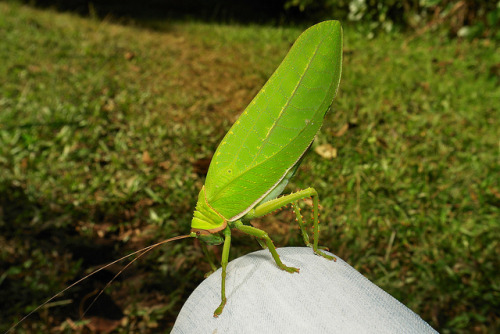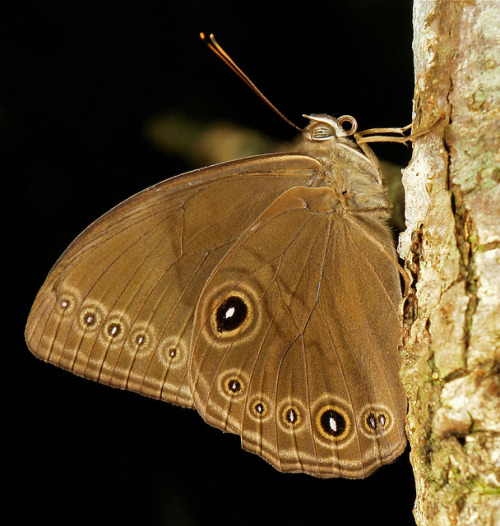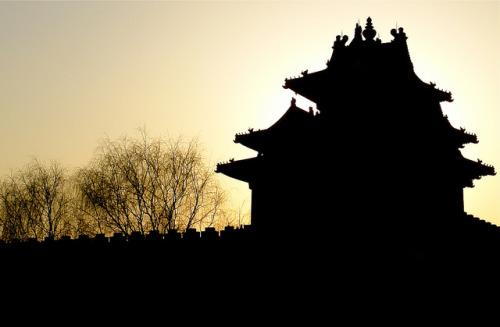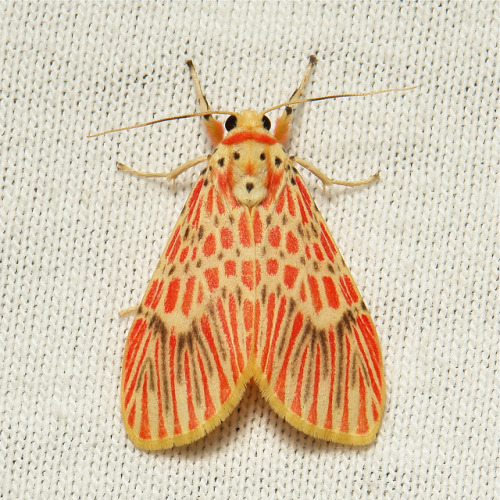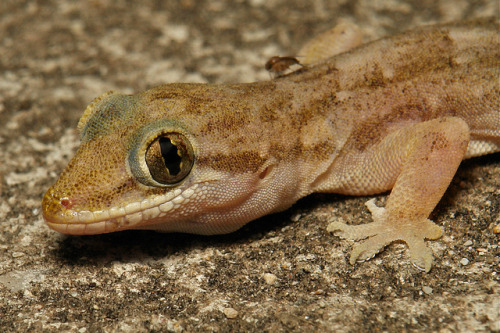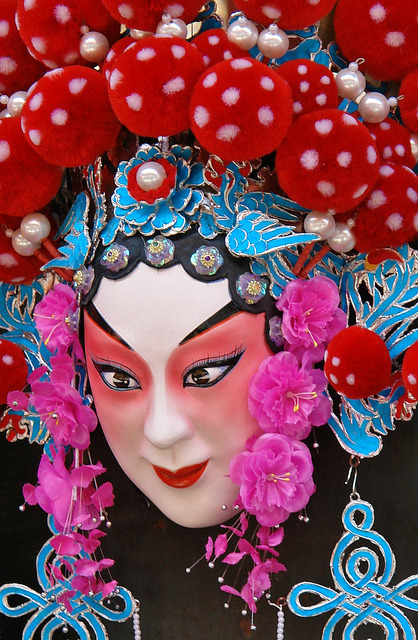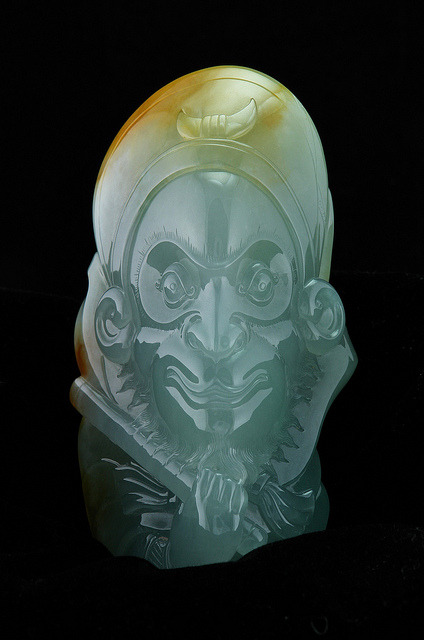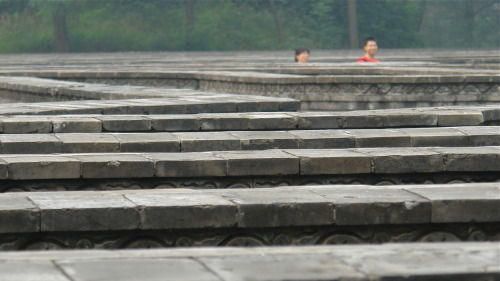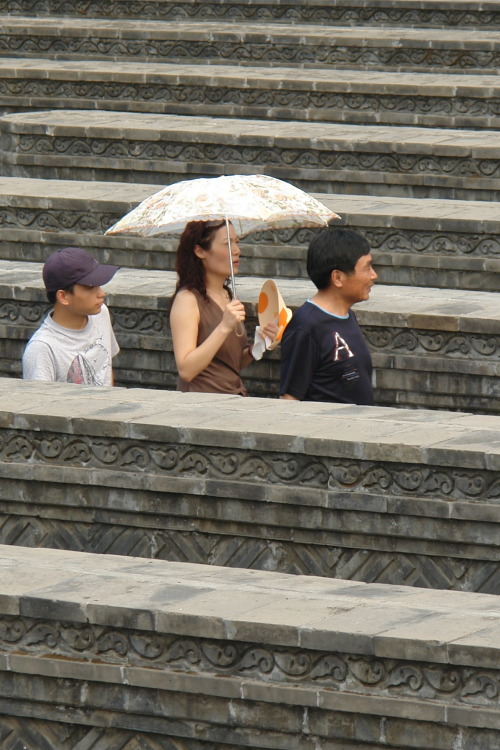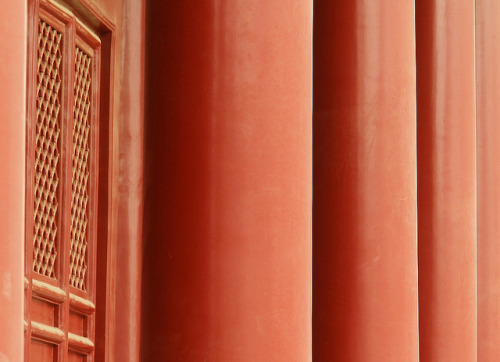#itchydogimages
Noctuid Moth (Erebus macrops, Catocalinae)
In Chinese folklore, legend has it that moths are human souls transformed. During Qing Ming (or Tomb Sweeping Festival) the souls will take the form of flying insects like butterflies and moths, to pay the living a visit.
The hills of Pu’er are dotted with hundreds of graves, some in congregations, others you will come across out of nowhere as individuals. Until recently, it was permitted (or at least unchallenged) to choose a family burial site on a hillside with a view at your discretion. Most of these tombs comprise a monumental headstone and altar and are tended annually at Qing Ming and/or on the anniversary of the deceased’s passing - the grave is cleaned, vegetation cleared, food offerings made and gaudy reflective decorations to deter evil spirits are erected.
Here is my “supernatural” story……
On one of the walking tracks I traverse regularly, is a pair of well-tended graves; one is a single, the other contains a couple. Last summer, on each occasion I passed, these mighty Erebus moths (they are as big as my hand) were in attendance. Always one on the single grave and two on the couple’s grave (pictured), tucked away in a dark corner under the tiled eaves of the tombstones. ( I am not kidding you).
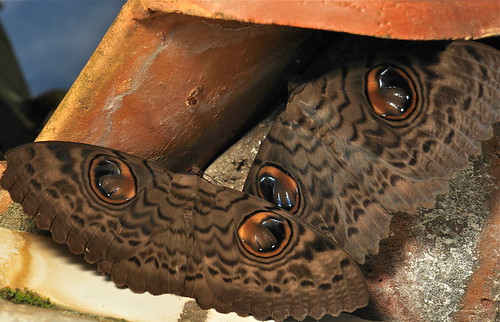
I always did my best not to disturb them as this is one “myth” I have come to respect. Occasionally though they flew away as I passed, yet obviously they returned. Presumably over the span of the summer months, these could not have been the same moths as they were invariably in pristine condition.
But regardless, it is sobering to think that the souls of the deceased are amongst us, and not too daunting to think they take the form of a noble moth.
bySinobug (itchydogimages) on Flickr.
Pu’er, Yunnan, China
See more Chinese moths on my Flickr site HERE…..
Post link
This attractive lizard inhabits various forest habitats including dry deciduous, coastal, and moist evergreen. It can be spotted on tree trunks, often low down.
Its identifying features are the single spine above each eye, and twin spines above the typanum (external ear-drum). Patterning and colouration can include various shades of brown, green and grey. Males are generally darker during the breeding season. The fingers and toes are of great length.
The Forest Crested Lizard ranges from India through Burma, southern China and Thailand to northern Peninsular Malaysia.

bySinobug (itchydogimages) on Flickr.
Pu'er, Yunnan, China
See other posts in this LIZARDS of CHINAseriesHERE.
See more images from China on my Flickr site HERE…..
Post link
Chinese Insects and Spiders
A whole heap more
Chinese Caterpillars
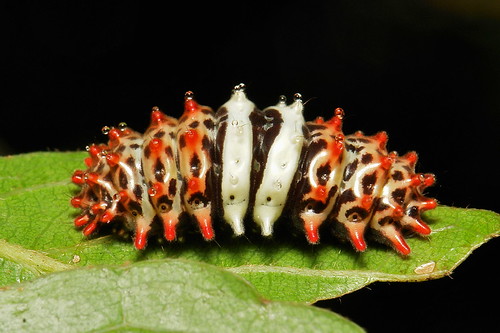
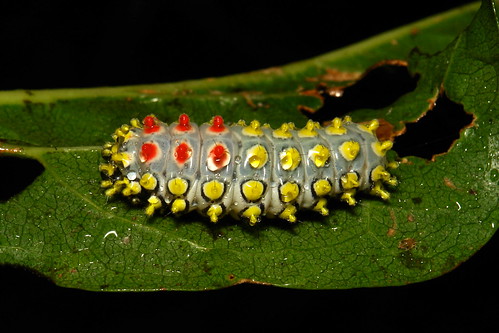

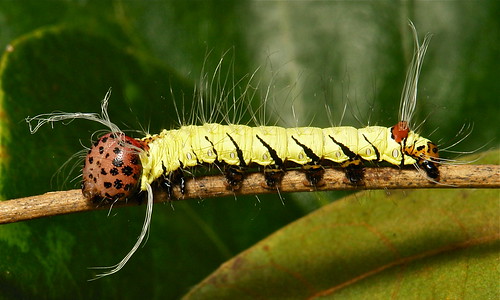
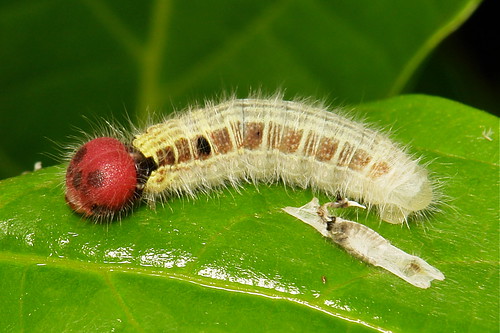
Click images to see identification (linked to their respective Flickr pages).
See others in the series of Chinese Caterpillars tumblr posts HERE.
See more Chinese caterpillars on my Flickr site HERE…..
Post link
There’s something on my knee……
Giant False Leaf Katydid (Pseudophyllus titan, Pseudophyllinae, Tettigoniidae)
If you have ever travelled or lived in China, you quickly observe that crowds form at the drop of a hat, whether it be to watch a game of chequers, minor domestic arguments, traffic accidents…and for foreigners. This happens in the big cities as much as it does in the more remote provinces, but when you are one of just a handful of 外国人(foreigners) in a third- or fourth-tier Chinese city and you are wielding a big camera with a flash diffuser AND you have China’s largest Orthopteran, P.titan (which very few Chinese people would be even aware exists), performing a threat display on your knee in the local park, the exponentially growing band of onlookers stands and stares in silent and, I will admit, unsettling curiosity.
So picture, if you will, the unseen scene in this image. I politely indicated that the crowd move aside so that I didn’t have them in the background of this shot. Behind and to the sides of me however, is a throng maybe two or three deep slowly creeping closer and closer as new arrivals at the rear of the pack push and strain to see what the commotion is.
I should have put my hat on the ground and collected some change…..
See more images of Pseudophyllus titan in my Flickr photostream HERE.
byitchydogimages on Flickr.
Pu'er, Yunnan, China
See more images from China on my Flickr site HERE…..
Post link
Chinese Insects and Spiders
…..and more
“TRUE” BUGS of China
Members of the Hemipteran suborder Heteroptera are known as “true bugs”. They have very distinctive front wings, called hemelytra, in which the basal half is leathery and the apical half is membranous. At rest, these wings cross over one another to lie flat along the insect’s back. These insects also have elongate, piercing-sucking mouthparts in which the mandibles and maxillae are long and thread-like, interlocking with one another to form a flexible feeding tube (proboscis) containing both a food channel and a salivary channel.
The immature stages of the heteropteran true bugs (nymphs) structurally resemble the adult form but are always lacking wings.
True bugs are generally well-known and include the stink bugs, assassin bugs, shield bugs, squash bugs and the aquatic water boatmen.
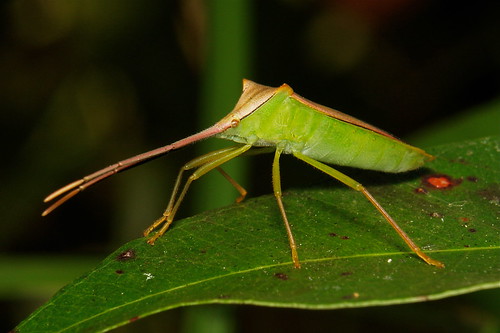

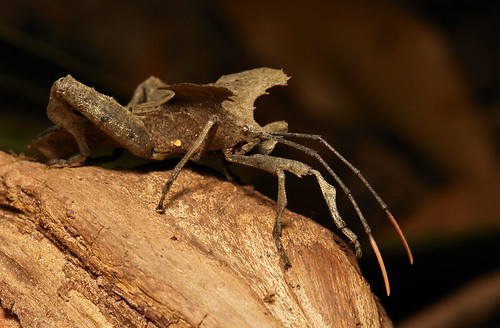

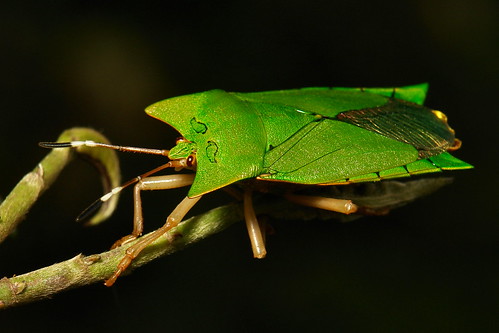
Click images to see identification (linked to their respective Flickr pages).
See others in the series of “TRUE” BUGS of China tumblr posts HERE.
bySinobug (itchydogimages) on Flickr.
Pu’er, Yunnan, China
See more Chinese true bugs and hoppers on my Flickr site HERE…..
Post link
Chinese Insects and Spiders
….more
Butterflies of China
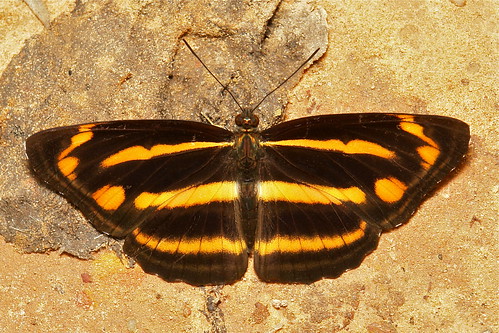
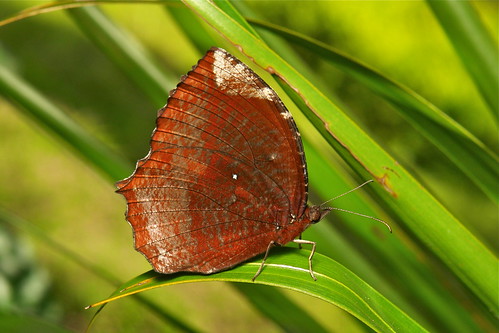
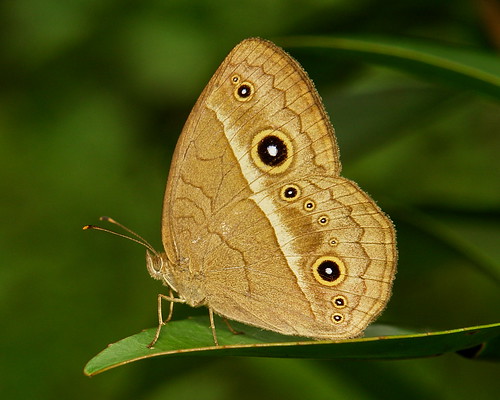

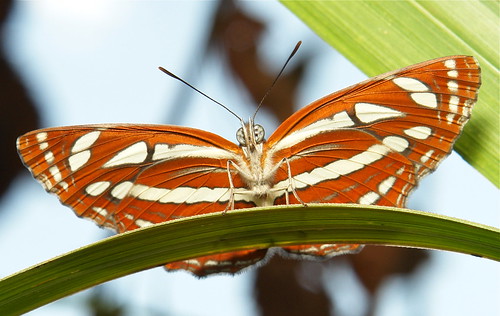
Click images to see identification (linked to their respective Flickr pages).
See my other Butterflies of China tumblr posts HERE.
See more Chinese butterflies on my Flickr site HERE…..
Post link
This is the view from the hilltop lookout over Pu’er City, Yunnan (yes the panoramic view is marred by multiple high tension electricity pylons and cables which miraculously disappear in promotional images for the city) as midnight approaches to bring in the Lunar New Year on January 31st, 2014 - The Year of the Horse. This is not a huge city by Chinese standards (a population in the surrounding district approaching 2.5 million), so I would consider this display quite impressive. Furthermore, the view into the distance is obscured by a heavy pall of smoke already in situ from the preceding hours leading up to midnight. I can never get tired of the enormity of this.
What you see is a healthy mix of tradition, male one-upmanship (“My box of fireworks is bigger than yours….oh….you have two boxes!”), a higher (probably non-disposable but increasingly disposable) income and a terrifying disregard for life, limb, property and the environment (but even I will disregard the latter in the heat of the moment).
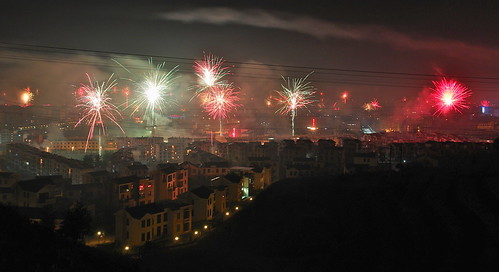
Love it or hate it, the sheer spectacle and abuse to one’s senses of a nation igniting fireworks, both on the stroke of midnight and for the proceeding two weeks until Lantern Festival (this year on February 14th), is a sight, smell, sound, taste and emotion second to none (in my humble opinion). This is not an orchestrated “Fourth of July” display or New Year’s Eve extravaganza, this is just every man and his dog letting off steam and sulphur fumes from their front doorstep, the roadside curb, the middle of the road, parks, carparks and rooftops either pooled with their neighbors or privately, as a deterrent to bad spirits in the upcoming twelve months.
This is my seventh New Year’s period spent in China. I arrived on New Year’s Eve 2008, flying into Beijing with the city below a carpet of (mainly red I recall) sky bursts. Subsequently, I have “survived” celebrations several times now in Beijing, in Chongqing, Sichuan, and this is my third in Pu’er, Yunnan.
Rich or poor (and these pyrotechnics are not cheap by Chinese standards), first-tier city or rural village, every man and his (only) son will light at least one fuse (and likely many more) during the Spring Festival period. With all considerations for pollution, waste and hazard to person and property aside, Chinese New Year is moving, exciting and illuminating. Imagine Fourth of July, New Year’s celebrations on Sydney Harbour, an Olympic opening ceremony and the sound and light show at any major techno party ever held combined and occurring simultaneously within sight and earshot, both on the ground and high above your head, and you are still not even close…..
Happy New Year to you all…… Gong Xi Fa Cai!
byitchydogimages on Flickr.
Pu'er, Yunnan, China
See more images from China on my Flickr site HERE…..
Post link
Mid-instar Chinese Oak Silkmoth Caterpillar (Antheraea pernyi, Saturniidae)
The Chinese (Oak) Tussah Moth (or “Chinese Tasar Moth”) is originally from southern China but as it has been used for tussah silk (a wild silk) production, they have been distributed more widely across subtropical and tropical Asia.
Tussah silk is the best-known and most widely used of all the wild silks. Moths have been raised outdoors on oak trees in China for more than two millennia. The natural color of the silk is a pinkish beige but depends on the climate and soil. In the 1970s and 1980s China expanded tussah sericulture to most of its provinces, but has since abandoned these efforts in the South. Tussah is now primarily grown in the Northeast, in the provinces of Shandong, Liaoning, and Hebei. It was introduced into Japan in 1877 where it was cultivated locally on a small scale in the 20th century. Tussah silk is also raised in both Koreas.
Because it is so easy to rear, Antheraea pernyi has been used in laboratories around the world to study diapause, endocrinology, and other aspects of insect physiology.
The reeled silk has a smooth sheen like domestic silk, but the rougher spun silk is highly favored by designers of high-end fashion to make women’s and men’s suits, blazers, dresses, shirts, scarves, and other garments and accessories. Sometimes tussah is blended with cotton or synthetic fibres. Tussah silk floss is also used in quilting to make duvets.
On a more technical note, Antheraea pernyi silk has more similar sequences to spider dragline silk than the silk from its domestic counterpart, Bombyx mori. Spider dragline silk exhibits exceptional strength, toughness, and resistance to mechanical compression, properties that rival those of synthetic high-performance fibres such as Kevlar. Consequently, there is a wide spread interest in mimicking natural silks in order to produce new classes of high-performance materials and tussah silk has potential as a resource for biospinning spider dragline silk.
bySinobug (itchydogimages) on Flickr.
Pu’er, Yunnan, China
See more Chinese caterpillars on my Flickr site HERE…..
Post link
Silhouette of the North-west Guard Tower of the Forbidden City against a Winter Sunset
byitchydogimages on Flickr.
Forbidden City / Palace Museum
Beijing, China
See more images from China on my Flickr site HERE…..
Post link
Chinese Insects and Spiders
Moths of China (Beijing and Yunnan)
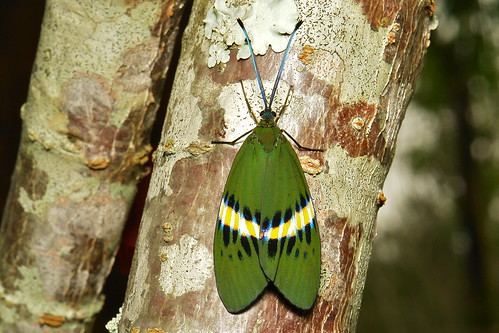
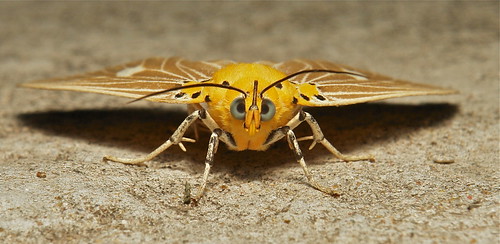
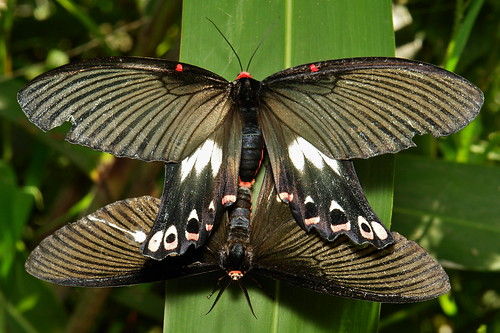

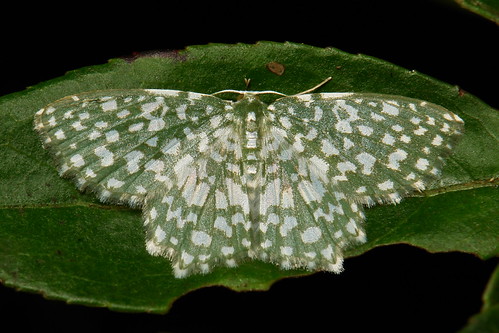
Click images to see identification (linked to their respective Flickr pages).
See my other Moths of China tumblr posts HERE.
See more Chinese moths on my Flickr site HERE…..
Post link
The western wall of Zhongnanhai government compound along Fuyou Avenue looking north from the corner of West Chang'an Avenue.
If you visit Beijing and the major tourist walking routes, you will pass this complex and its flagpoled entrance with immaculately presented armed guards and police presence (uniformed and otherwise) and wonder what it is and what lies behind the walls. I would love the opportunity to have a look inside but rest assured the likelihood of this happening is less than zero.
Zhongnanhai is often used as a metonym for the Chinese leadership at large (in the same sense that the term White House frequently refers to the President of the United States and his associates). The state leaders, including Xi Jinping and Hu Jintao, and other top CPC and PRC leadership figures carry out many of their day-to-day administrative activities inside the compound, such as meetings with foreign dignitaries. China Central Television frequently shows footage of meetings inside the compound, but limits its coverage largely to views of the interior of buildings.
The complex is blessed with a remarkable history, practically unseen by the contempory public eye…..
The name of the Zhongnanhai complex, located west of the Forbidden City, means “central and southern seas/lakes”, referring to two lakes (the “Central Sea” and “Southern Sea”) located within the compound; it is sometimes translated as “Sea Palaces”. These two lakes are part of a series of irrigation projects carried out during the construction of the nearby Forbidden City. Also part of the same system is the “Northern Sea”, or “Beihai”, now a public park.
After the Qing Dynasty established its capital in Beijing, the government reduced the size of this royal park to within a small walled area around the three lakes. Several successive emperors built pavilions and houses along the lake shores, where they would carry out government duties in the summer. During the reign of the Empress Dowager Cixi, the Empress Dowager and the Emperor would often live in the Zhongnanhai compound, travelling to the Forbidden City only for ceremonial duties.
During the Boxer Rebellion of 1900, the Russian army occupied Zhongnanhai. Almost all artifacts and decorations in the compound were looted. Later, the Eight-Nation Alliance commander also lived in Zhongnanhai. When Puyi was crowned Emperor, his father as the Prince Regent lived for a short time in the compound.
Zhongnanhai attained political significance during the Republic of China era, when the Beiyang Government under Yuan Shikai placed its headquarters in the Zhongnanhai compound from 1911. This decision was made because the regime wished to house its government very close to the historical centre of power, the Forbidden City, but could not use the Forbidden City itself because the abdicated Emperor Puyi still lived there.
Zhongnanhai served as a government centre again from the early days of the People’s Republic of China, founded in 1949, which built many of the structures in the compound. The compound housed the Communist Party of China Central Committee, as well as the State Council. Early leaders, such as Mao Zedong, Zhou Enlai, and Deng Xiaoping lived in the compound.
SinceZhongnanhai became the central government compound, it has been mostly inaccessible to the general public in the same way the Forbidden City was during the imperial era. The exception to this was during the years of relative freedom following the end of the Cultural Revolution, when the compound was open to members of the public, who could obtain tickets to visit the compound from relevant government authorities. Following the political turmoil that culminated in the Tiananmen Square protests of 1989, security was greatly increased. Access has now been closed to the general public, with numerous plain clothed military personnel patrolling the area on foot. Cars, moreover, are now prohibited from stopping on stretches of adjacent roadway for any reason.
The most important entrance to the compound is the southern one at Xinhuamen (Xinhua Gate, or “Gate of New China”), surrounded by two slogans: “long live the great Communist Party of China” and “long live the invincible Mao Zedong Thought.” The view behind the entrance is shielded by a traditional screen wall with the slogan “Serve the People”, written in the handwriting of Mao Zedong. The Xinhuamen entrance lies on the north side of West Chang'an Avenue.

byitchydogimages on Flickr.
Beijing, China
See more images from China on my Flickr site HERE…..
Post link
The Common House Gecko is a native of southeastern Asia. It is also known as the Pacific House Gecko, the Asian House Gecko, or simply, the House Lizard. Most geckos are nocturnal, hiding during the day and foraging for insects at night. They can be seen climbing walls of houses and other buildings in search of insects attracted to porch lights, hence their name “House Gecko”. Spread around the world by ships, these geckos are now common in the southern United States, large parts of tropical and sub-tropical Australia, and many other countries in South and Central America, Africa, Asia, and the Middle East.
The gecko community at my house have a pretty good life with a smorgasbord of insect life at their disposal attracted to the MV night light when I am photographing night-flyers.
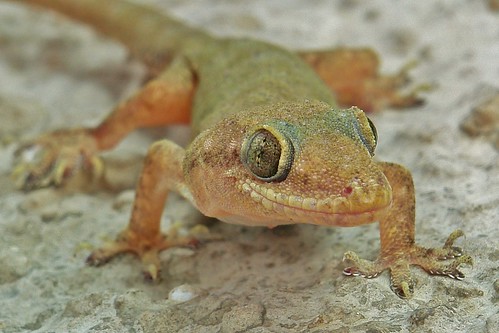
bySinobug (itchydogimages) on Flickr.
Pu'er, Yunnan, China
See other posts in this LIZARDS of CHINAseriesHERE.
See more images from China on my Flickr site HERE…..
Post link
Opera Mask
Panjiayuan Market
Beijing, China
byitchydogimages on Flickr.
See more images from China on my Flickr site HERE…..
Post link
Sunset
Sunset from Forbidden City, Beijing
byitchydogimages on Flickr.
Beijing, China
See more images from China on my Flickr site HERE…..
Post link
Jade Monkey King
The Monkey King is a main character in the classical Chinese epic novel Journey to the West. In the novel, he is a monkey born from a stone who acquires supernatural powers through Taoist practices. After rebelling against heaven and being imprisoned under a mountain by the Buddha, he later accompanies the monk Xuanzang on a journey to retrieve Buddhist sutras from India.
(purchased Foshan, Guangdong, China)
byitchydogimages on Flickr.
Pu'er, Yunnan, China
See more images from China on my Flickr site HERE…..
Post link
Golden Tree Frog, Common Tree Frog, Four-lined Tree Frog, or Striped Tree Frog (Polypedates leucomystax, Rhacophoridae)
Polypedates leucomystax is widely distributed throughout South and Southeast Asia, hence it’s variety of common names. It thrives in both wetlands and forests. In urban settings, P. leucomystax can be found in garden ponds, on buildings, and on roads.
Breeding is year-round in some parts of the range but in drier areas, breeding is restricted to the start of the wet season. Males congregate at still or slow-moving water, or puddles, and call from the edges or elevated positions on vegetation. The call has been described as a “widely spaced nasal quack, and occasionally a low throaty chuckle”. Females deposit from 100-400 eggs in oval-shaped foam nests. The foam nests measure about 10 cm in length and are constructed on vegetation above ephemeral pools, or attached to a surface by the water’s edge. Hatching takes place after three to four days, occurring at the external gill stage. At this point the larvae wriggle free of the foam nest and drop into the water below. The larvae are opportunistic predators, attacking and consuming nearly anything they can, including both live and dead conspecific tadpoles and decaying vegetation. From hatching to metamorphosis takes approximately seven weeks.
bySinobug (itchydogimages) on Flickr.
Pu'er, Yunnan, China
See other posts in this CHINESE FROGS and TOADSseriesHERE.
See more images from China on my Flickr site HERE…..
Post link
Doorway Decor
Forbidden City (Palace Museum)
Beijing, China
byitchydogimages on Flickr.
Beijing, China
See more images from China on my Flickr site HERE…..
Post link
Xiyang Lou (literally “Western mansion(s)”) are ruins of 18th-century European-style imperial buildings on the grounds of the Old Summer Palace in Beijing. The Xiyang Lou were commissioned by the Qianlong Emperor and designed mainly by the Italian Jesuit Giuseppe Castiglione who was in his service as a court painter. Castiglione relied on the French Jesuit scientist Michel Benoist for the engineering tasks, in particular for the fountains, which were the chief interest of the emperor. Construction was carried out by Chinese craftsmen working under their supervision.
Planning of the gardens started in 1747 and four years later in 1751, the first waterworks were completed. Other milestones were the building of a large labyrinth in the years 1756 to 1759 and an observatory which was added in 1783.
Like the rest of the Old Summer Palace, the Xiyang Lou was destroyed in a fire laid by the Anglo-French allied forces in 1860 during the Second Opium War. However, since the masonry work was not consumed by the fire, significant ruins of many of the buildings can still be found on the site.
Some conservation work on the site was carried out between 1977 and 1992. The Huanghuazhen labyrinth was rebuilt during this time.
Huanghuazhen (literally “yellow-flower maze”) is a maze formed of 1.2 metre-high embossed-brick walls covering an area of 89 by 59 metres. The total length of the walls is 1.6 kilometres. In its centre sits a European-style circular pavilion. The emperor is said to have sat in this pavilion to watch his concubines competing in a race with yellow lanterns through the labyrinth on the occasion of the Mid-Autumn Festival.
It is tragic that the Old Summer Palace met its demise so brutally at the hands of Europeans. Visiting the gardens is a sombre experience. The ruins of the Western Mansions alone, although now pathetic, well-trodden and worn by swarms of tourists without any understanding of what they are visiting, conjures up visions of grandeur difficult to comprehend, and completely out of place in the sweeping traditional Chinese architecture which once surrounded them. I advise doing some research in advance to get your bearings and apply some educated imagination on such a visit to get a feel for what once had been.
byitchydogimages on Flickr.
Beijing, China
See more images from China on my Flickr site HERE…..
Post link
The Common House Gecko is a native of southeastern Asia. It is also known as the Pacific House Gecko, the Asian House Gecko, or simply, the House Lizard. Most geckos are nocturnal, hiding during the day and foraging for insects at night. They can be seen climbing walls of houses and other buildings in search of insects attracted to porch lights, hence their name “House Gecko”. Spread around the world by ships, these geckos are now common in the southern United States, large parts of tropical and sub-tropical Australia, and many other countries in South and Central America, Africa, Asia, and the Middle East.
The gecko community at my house have a pretty good life with a smorgasbord of insect life at their disposal attracted to the MV night light when I am photographing night-flyers.
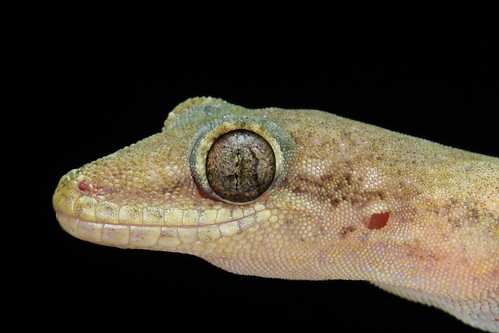
bySinobug (itchydogimages) on Flickr.
Pu'er, Yunnan, China
See other posts in this LIZARDS of CHINAseriesHERE.
See more images from China on my Flickr site HERE…..
Post link
A Preponderance of Pillars
Beijing Working People’s Cultural Palace, Imperial Ancestral Temple,
byitchydogimages on Flickr.
Beijing, China
See more images from China on my Flickr site HERE…..
Post link





